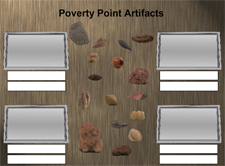Typology
As mentioned in the Site Overview, over one million artifacts have been recovered from the Poverty Point site. In order to make sense out of all this material, archaeologists first sort and classify the artifacts. This is known as typology. The purpose of creating a typology is to simplify the variability in the assemblage and help reveal meaningful patterns. The same artifact may be classified in many different ways depending on the research question you are investigating. For example, the culture historians were primarily concerned with ordering material in time and across space to create archaeological phases. Had their primary goal been to reconstruct past behavior, their typologies may have been quite different.
The basic unit of classification is the type. Thomas and Kelly (2006:211-212) describe three kinds of types:
- Morphological Types: A descriptive and abstract grouping of individual artifacts whose focus is on overall similarity rather than function or chronological significance.
- Temporal Types: A morphological type that has temporal significance; also known as a time marker or index fossil.
- Functional Type: A class of artifacts that performed the same function; these may or may not be temporal and/or or morphological types.
Differences in artifact attributes may be due to:
- Technology: the manufacturing of an object (either raw materials or processes used)
- Function: the use or purpose of an object.
- Style: the decoration, aesthetics, or any non-practical, non-utilitarian, non-functional aspect of an object.
Poverty Point artifacts before sorting.
 |
Interactive ActivityIn the following pages you will get practice at sorting and classifying objects, using examples from the Poverty Point site.
|
*Definitions and additional content from: Thomas, David Hurst and Robert L. Kelly (2006). Archaeology (Fourth Edition). Thomson Wadsworth

